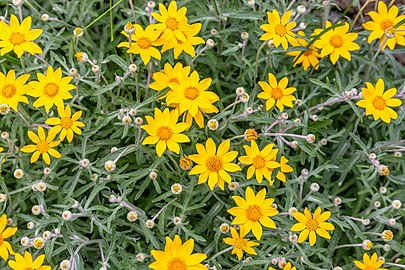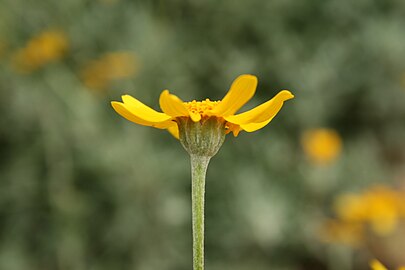
Common Woolly Sunflower
Eriophyllum lanatum var. grandiflorum
The Woolly Sunflower is a common attraction along the Trinity River corridor and watershed. In our area, viewers can see it in a few different varieties split between high and low country. The low country version is found in large colonies exposed to dry and hot conditions. Viewers commonly see it along roadsides defying logic by clinging to rocky cliffs showing off their sweet yellow pedals and silvery leaves and stems.
Photo of a patch of Common Woolly Sunflower taken near Burnt Ranch, generously provided by Veronica Yates.

Eriophyllum lanatum is a perennial herb native to western North America. It has long, thin stems with small pinnately lobed, green leaves and small, yellow flowers. When you get up close and personal you notice a few unique characteristics. Prior to the bloom, the tips of the flower buds turn a sweet reddish purple and the silvery color of the stem and underside of the leaves is actually a layer of tiny hairs. These hairs serve a specific purpose for the plant and act to conserve water by reflecting heat and reducing air movement across the leaves surface [1]
Photo: taken at the Oregon Gulch Restoration Site. E. lanatum was a part of the seed mix dispersed post restoration as part of the revegetation efforts by Hoopa Valley Tribal Fisheries. Photo generously provided by Veronica Yates.
This perennial plant’s bloom is prolific and prolonged typically beginning in March and lasting sometimes into August making it of special value to native bees, butterflies, and other important pollinators who are attracted by the bright yellow sunflower-like pedals. Due to this wildflower’s showy nature as well as its excellent tolerance to drought, it makes for a terrific addition to cultivated butterfly gardens. It can be propagated by seed, cuttings or by inquiring to purchase from your local nursery [2].


The woolly sunflower has been recorded to be used by the people of the Miwok tribe (California) to sooth aching parts of the body by making a poultice of the leaves; the Skagit (Washington) rub the leaves on skin to prevent chapping; and the Chehalis (Washington) use the dried flowers as a love charm [3].
References
- Wikipedia, Eriophyllum lanatum
- NRCS, USDA.gov, Propagation Protocol Eriphyllum lanatum
- Native American Ethnobotany Database 2011, Eriphyllum lanatum
- USDA Plant Guide
- eFlora.com, Eriophyllum lanatum – Woolly eriophyllum
- iNaturalist photo gallery, Eriophyllum lanatum vir. grandiflourm
